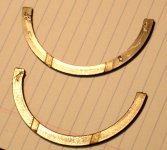TR4 said:
Has anyone documented this effort? I would like to check the thrust washers on the 4 so if a step by step is available, I sure would appreciate that.
As noted by others, it is not a difficult fix. Paul Tegler has a pretty good writeup for Spitfires, and I believe it should be pretty much the same for TR's. Check this link:
https://www.teglerizer.com/triumphstuff/thrustwashers.htm
I found getting the sump off was the worst part of it. The PO had used some kind of adhesive on the pan gasket, and it took a certain amount of cursing to get it to move. It's just a messy place to work anyway.
Once the pan is off, the rear bearing housing is easy to get at. Just take out the two bolts and give it a tug or a bit of a pry and it should come straight down. It sticks on the crank pretty tight. Try not to dislodge the bearing mounted in its housing, and make a note of which side of the housing faces the front of the car, so you can make sure the main bearing goes back in the right way round.
The manual talks about rotating the crank to get the thrust washers out and to reinstall them, but I didn't need to do that. You can see the ends of the washers clearly with the main bearing removed. I just used a spring hook to poke one side of the washer up, and it naturally rotates itself around the crank and out. To get them the last bit out, I used one of those magnets-on-a-pointer to just grab it and rotate it out off the crank.
You should use a micrometer to measure the washers that come out. If you add up these measurements, plus the measurement you got when you used the dial gauge to check end play, you should have a pretty good idea of the total possible axial movement of your crank. This will give you an idea of whether you need standard size replacement washers or oversize. Standard washers are .090", and you can get oversizes of 5-10-30 thousandths, maybe others.
My total endplay was .195" with no washers. I allowed for .005" endplay (spec is .004"-.008" for my Spit) to give me .190, so I planned to use two 5-thou oversize washers. I ordered both standard and 5-thou oversize. You need to measure these with a micrometer too, because they are not exact. I found the 'standard' size actually measured .092+" and the oversize .096+". So I wound up installing one standard and one oversize, that's all I could get in there. As it turns out, my end-play now measures .005" so go figure.
When you reinstall, some manuals show the oil grooves pointing the wrong way. Make sure you install the new ones with the oil grooves facing *away* from the crank bearing (i.e. the rear washer will have oil grooves facing the rear of the car, the front washer grooves will face the front of the car).
I installed the rear one first. Push back on the crank to give yourself maximum clearance, and it should just slip right in. Remember to lubricate it with engine oil or Lucas oil before installing. Once the back one is in, press your clutch to give you maximum clearance for the front washer and install the appropriate size. You should have just enough clearance that you can push one end in and just rotate it into place.
Lubricate the main bearing, pop it into place and torque it up. Done. Restest with a dial gauge to make sure while you still have the pan off.

 Hi Guest!
Hi Guest!

 smilie in place of the real @
smilie in place of the real @
 Pretty Please - add it to our Events forum(s) and add to the calendar! >>
Pretty Please - add it to our Events forum(s) and add to the calendar! >> 
